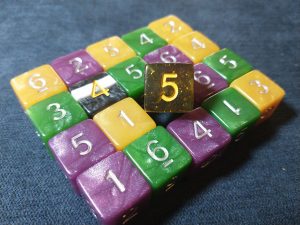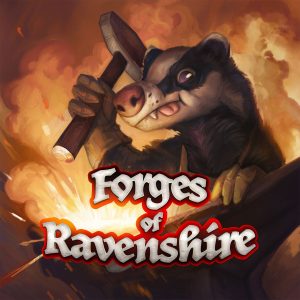 As is often the case, it was the cover that first drew my attention. At a convention this summer I passed a booth sporting a poster of a crazed-looking hammer-wielding badger, and on a table beneath was sprawled a glorious array of boards and components, with various tracks and spaces for placing cubes and dice. I wasn’t sure what it was, but it looked like a lot of fun. I stopped for a closer examination and, after a chat with the designer, walked away with a copy of the game.
As is often the case, it was the cover that first drew my attention. At a convention this summer I passed a booth sporting a poster of a crazed-looking hammer-wielding badger, and on a table beneath was sprawled a glorious array of boards and components, with various tracks and spaces for placing cubes and dice. I wasn’t sure what it was, but it looked like a lot of fun. I stopped for a closer examination and, after a chat with the designer, walked away with a copy of the game.
Everything comes down to gameplay though, no matter how unique a cover, no matter how much euro-y deliciousness oozes from dozens of colorful cubes and dual-layered boards. So now that I’ve had some time to explore the game beyond that initial impression, what did I actually think of it?
Forges of Ravenshire is a dice placement game of gathering and crafting for 1-4 players. Its listed playtime is 50-100 minutes.
Gameplay Overview:
The goal is to have the most money at the end of the game. During setup, each player receives a player board, ten cubes in their chosen color, and three dice (one in each of the three colors).

The game is played over the course of four seasons and each season is divided into three phases. To start, players roll their three dice, then play through the Gathering phase, during which they will take turns placing a die and gaining the associated reward, then removing another die and gaining the associated reward. The die they removed from the central board is placed on the matching guild on the left side of their personal player board. There are three guilds that start out with basic abilities. Throughout the game players can purchase new tiles to add to the guilds, thus making them stronger. Guild tiles produce goods or offer special trade opportunities for players.

After each player has placed and taken three dice (and ran the guilds for each taken die), the game moves to phase two: the Production phase. During this phase, players will move dice from the guild area on the left side of their board, to the production spaces on the right side of their board. All players act simultaneously during this part. Here players can convert raw materials collected during gathering into refined materials and gain other goods and benefits. Again, the values of the dice will factor in during this phase, influencing what, or how much of something, is gained. During this time players can also spend goods to complete contracts they acquired during the previous phase. Each contract will award a certain amount of gold and other bonuses.
Phase three of the game is the End of Season phase, or cleanup. Players will take the three dice they placed on their board and re-roll them to be used during the next round. The six dice on the central board are also rolled and randomly redistributed onto the six areas.
The game ends after the production phase of the fourth season and the player with the most gold wins.

Game Experience:
That was just a brief overview. There is a lot happening in this game, but hopefully, that was enough to give you an idea. At its heart this is a resource conversion game—turn stuff into other stuff, and maybe into other stuff after that, so you can get gold and win. That mechanism can feel dry or arbitrary, but with some unique twists, it can turn into a lot more.
There are several things Forges of Ravenshire does to elevate itself above just a game of endless conversions. The first is the “place a die, take a die” mechanism.” This adds weight to each placement decision because you’re considering so many facets of that decision: “If I place this number here, I’ll get leather… then I could take from over here to get ore, but I really want a green die, and I really need a die with a value of 5, but if I place a die over here I’ll get a relic that lets me change the value…”

Puzzling out how best to execute your actions is, quite simply, delightful. A board with only six locations feels like just enough because you’re double-dipping every turn. You’re also considering that the die you take will play a role during the next phase of the game.
There are ways to upgrade, trade, mitigate, and manipulate, so I never felt like success or failure hinged on luck, as can sometimes be the case in dice games. There’s usually a way to accomplish what you want, or at least the next best thing. You need to plan ahead a little, but not entirely, because what you do will depend a lot on the board state when your next turn comes along. This makes for a nice balance of long-term strategy and thinking-on-your-toes tactics.
That said, all that puzzling may lead to a certain amount of analysis paralysis at times, and after multiple steps, you might forget what you were even trying to accomplish to begin with. This can affect game length somewhat, and I felt the average playtime leaned more toward 100 minutes than 50, especially with new players. Once you have some experience though, games will get shorter.

During the gathering phase player turns are usually pretty quick because you’re simply placing a die and taking a die, and you only have six locations to choose from. Once you take a die and begin running your guild the next player can take their turn, which keeps things moving along nicely. The part that has players bent over their boards and thinking is the simultaneous production phase. All players acting at once helps a lot, but it’s possible someone will get caught in a data loop and take some time to work through this phase.
And, yes, there is a decent amount of time in this game that will be spent in your own head, thus there’s not a lot of player interaction. Personally, I’m a fan of multiplayer solitaire and dislike “take-that”, so I had zero problems with this, and the only time it felt like I was actually ignoring other players was during the production phase when we were all focused on our own boards. But there are still those tense moments during gameplay where you’re holding your breath, hoping someone won’t take the die, contract, or guild tile you want! It’s the players who influence the main board so what other people do matters to you during the gathering phase. There are also “Titles” players will be competing to accomplish first, so you want to keep at least half an eye on your opponents.

I didn’t mention it during my rules overview, but players will receive a unique assistant ability at the start of the game (this rule is optional, but recommended), and this can help give focus, as well as differentiate players from one another by giving them a unique strength. Every one of these abilities feels overpowered, which means none really are. I found them to be an excellent addition to the game and will likely always choose to play with them. Two of the more exciting ones add unique dice to the game that will help shape your strategy. Though there was an instance where an ability led to an overabundance of a specific resource, to the point of being almost ridiculous- but not necessarily bad.
Final Thoughts:
Forges of Ravenshire takes mechanisms we’re familiar with and spices them up, mixing just enough of the new with the familiar to keep players engaged. Maybe not necessarily revolutionary, but it did feel unique. The joy of the game comes through the dice placement, while the satisfaction comes in pulling off what you want to accomplish through finagling resources and abilities. The game will reward careful planning and maximizing your assets; and, among experienced players, the win will often be a close thing. It’s a mechanism first game, there’s lots of mental gymnastics, and as you play the theme sort of stops mattering because you’re busy crunching numbers, but I was having so much fun just running the system that I didn’t even mind. Overall, you can see that lots of care and thought went into the design and I look forward to future titles from this publisher.
Final Rating: 4 Stars – Two hammer-wielding-crazy-eyed-badger thumbs up!
 Hits:
Hits:
• Good balance of tactics and strategy
• A unique twist on worker placement
• Dual layered player boards, quality inserts, and overall great production
Misses:
• Requires lots of mental math and time in your head, which can lead to overthinking
• Theme takes a backseat- you think more about what you’re doing than why
Source: Board Game Quest





